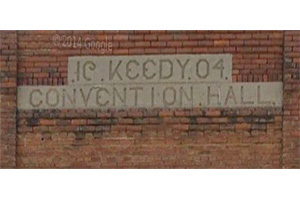 Fargo-sized, at least by my estiation of these things. Sixty-plus thou, which is a perfect size for a town - big enough for intra-city rivalries and old buildings o substance downtown. Fargo-sized, at least by my estiation of these things. Sixty-plus thou, which is a perfect size for a town - big enough for intra-city rivalries and old buildings o substance downtown.
Indiana has some old towns, and this is one; dates back to 181. Midwestern, but of the easterly variety.
Any doubt what this is?
The courthouse AND the jail; one stop shopping. Second Empire style. But what’s next door?
It’s the historical museum now, but don’t you suspect it was once an important civic building in its own right? You’re right : the old Sheriff’s resident.
All the fashion once. Addams-Family cliche today.

Courthouse Square is the area around, well, you know. It’s historic, but some buildings have been touched, shall we say, by the rude hand of modern tastes:
Who built it?
It’s tough, but searching for “AYLOR,” which was all I could make out for certain, yielded CAYLOR, which indeed was the store that occupied the ground floor.

That’s . . . interesting.
Times must have been good when you could give up that much rentable space.

I can’t resist the old neon::
From their website:
The first tavern opened in the new J.L. Evans Building. The tavern benefitted from nearby railroad traffic and it offered lodging on the upper floors. The building has always been used as a tavern except during the years 1909 to 1933 when alcohol sales were prohibited by the government. Walter Carey and Sid Gill opened Syd's in 1945 and installed the locally famous shuffleboard game in the middle of the bar. They also coined the familiar Syd's catch-phrase "Howdy Bub".
Nearby railroad traffic, eh?
Let’s go back to street level, and see if there are any signs of a station - whoa.
Indy Star:
It’s been the talk of the courthouse square for three weeks.
The old-fashioned, 70-foot-long passenger rail car just seemed to appear one night, with no explanation, between a couple of restaurants and a dry cleaner in the heart of downtown. It doesn't pick up any passengers, and no one gets on or off. But there it sits, on the Nickel Plate tracks at 8th and Logan streets, and few people know why.
As it turns out, the 1929 passenger car is on loan to the Nickel Plate Express, but the train operator doesn't have anywhere to put it just yet. So railroad officials decided to park it in the safest place they could think, a busy downtown intersection, but out of the way of auto traffic.
You know a form of transportation has fallen out of the public imagination when people cross the trakcs without looking or caring.
 Well, that’s . . . an interesting way to do it. Well, that’s . . . an interesting way to do it.
What are the K of P?
The Knights! The Knights who say Pythias!
The Knights of Pythias is a fraternal organization and secret society founded in Washington, D.C., on 19 February 1864. The Knights of Pythias was the first fraternal organization to receive a charter under an act of the United States Congress. It was founded by Justus H. Rathbone, who had been inspired by a play by the Irish poet John Banim about the legend of Damon and Pythias. This legend illustrates the ideals of loyalty, honor, and friendship that are the center of the order.
 This might be one of the most mystifying small town Main Street buildings I’ve ever seen. This might be one of the most mystifying small town Main Street buildings I’ve ever seen.
The bricked-up windows look as if they’ve always been bricked up. If they weren’t, that was one hell of an expanse of glass.
 Leonard had every reason to be proud. Leonard had every reason to be proud.
It’s a solid thing, with those little touches on top to provide a bit of . . . whimsy? No. Grace? No. Delicacy? Perhaps.
 I love these. If humankind was wiped out by a plague, and a few decades later aliens landed, they might conclude that this was the Roman Embassy. I love these. If humankind was wiped out by a plague, and a few decades later aliens landed, they might conclude that this was the Roman Embassy.
That presumes a lot of anthropomorphic assumptions about aliens and what they would figure out. Anyway, I think the reason I went to Noblesville in the first place was a plate I found in an old architectural mag.
The interior:
A great place to wear a fez and send a confused time-traveling girl back to the future, if you ask me.
If you got that reference, feel free to preen in the comments. ;)

|




 Fargo-sized, at least by my estiation of these things. Sixty-plus thou, which is a perfect size for a town - big enough for intra-city rivalries and old buildings o substance downtown.
Fargo-sized, at least by my estiation of these things. Sixty-plus thou, which is a perfect size for a town - big enough for intra-city rivalries and old buildings o substance downtown. 































